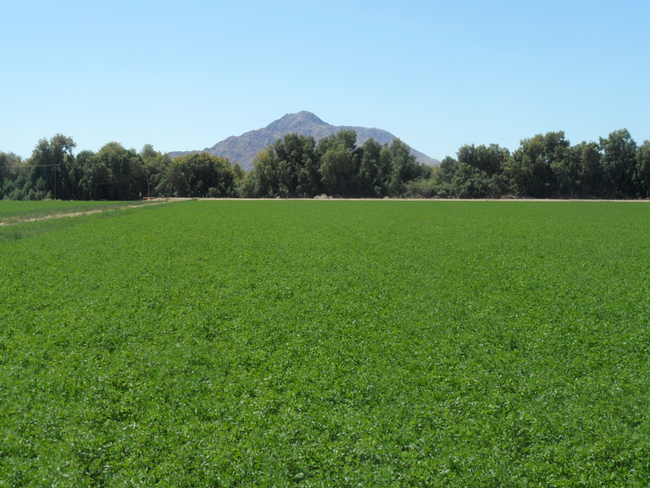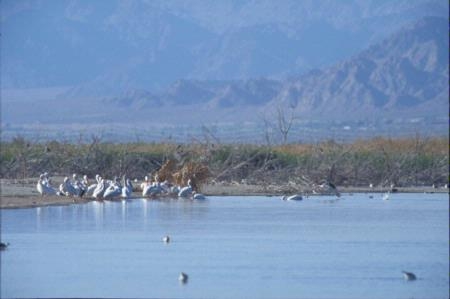Posts Tagged: Khaled Bali
Drip irrigation in alfalfa cuts water use, but isn't for everybody
The drought is forcing farmers to reexamine the way they water their crops, but converting to drip irrigation in alfalfa is unlikely to be widely implemented, reported David Wagner on KPBS Radio News.
The drip irrigation system conserves water - almost by half, said farmer Jack Cato - but is expensive and requires regular maintenance. After six years, the drip system is yet to pay for itself.
"Drip irrigation is not the answer for everything," said Khaled Bali, irrigation advisor with UC Agriculture and Natural Resources (UC ANR). "I would not recommend switching every acre in the Imperial Valley to drip irrigation."
Cato added that new drip irrigation users face a steep learning curve.
"Whatever farm starts doing this, he needs to take baby steps," Cato said. "It's not something you learn overnight, or in a book. You have to study your fields daily."
For more on water use and alfalfa, see Why alfalfa is the best crop to have in the drought by Daniel Putnam, UC ANR Cooperative Extension specialist based at UC Davis, in the Alfalfa & Forage Blog.
Scientists seek solutions to Salton Sea woes
The rotten-egg stink that invaded Southern California in September was blamed by scientists on an unfortunate combination of a large fish die-off in the Salton Sea, a storm churning the fetid lower levels of the sea and unusual gusts from the southeast blowing the odors toward Los Angeles, according to the Los Angeles Times.
That was just latest episode in a series of environmental woes for the lake that formed 150 miles southeast of Los Angeles in 1905 when the Colorado River flooded the Sonoran Desert. Now the Salton Sea is mainly fed by fresh water drainage from nearby farms and waste water from Mexicali, but becoming more salty as evaporation outpaces its replenishment. UC scientists are working on ways to improve the quality of the inland sea to make it more hospitable to wildlife.
Nitrogen and phosphorus are two main nutrients that spur algae growth and lower dissolved oxygen concentrations that cause massive fish kills in the Salton Sea.
Imperial Valley growers often fertilize their crops with nitrogen and phosphorus in irrigation water. Khaled Bali, UC Cooperative Extension advisor in Imperial County, gives growers “best management techniques” to ensure fertilizers are applied correctly so the nutrients end up the plants, not flowing into the Salton Sea.
“One of the irrigation management practices that we developed at the UC Desert Research and Extension Center is used in the valley to conserve water and improve water quality,” Bali said. “Implementation of this practice on commercial farms increases water use efficiency by more than 12 percent and reduces the load of sediment and soluble phosphorus in drainage water by more than 50 percent.”
A recent UC Berkeley study has demonstrated a cost-effective method for using manmade wetlands to clean contaminants out of the waters that flow into the sea, which is overly salty from evaporation and polluted with selenium, fertilizer nutrients and other chemicals from agricultural run-off.
The study was aimed at providing a wildlife habitat at the south end of the sea with low-salt, clean water, but the new wetland design also has the potential for broader environmental and agricultural applications, researchers say.
“No other published studies have shown any cost-effective system that approaches this level of efficient selenium removal,” said Norman Terry, professor in the Department of Plant and Microbial Biology at UC Berkeley, and principal investigator of the study. “The only other way to get water this clean is to use microbial bioreactors, which are prohibitively expensive and not feasible on the vast scale of the Salton Sea.”
In the proposed multi-step process, water from the Alamo or New River would be pumped into a sedimentation pond, and then allowed to flow through an algae pond and into a constructed wetland growing cattail plants before it finally enters into the species conservation habitat.
Terry’s next step is to obtain funding to build a pilot wetland to test the design in the field.
The study, published in the November 6 issue of Environmental Science and Technology, was funded as part of the California Department of Fish and Game's and Department of Water Resources’ efforts to develop pilot restoration projects that provide feeding habitat for migratory, fish-eating birds.
Alfalfa is ice cream in the making
When Khaled Bali looks at ice cream he thinks about alfalfa, wrote Alejandro Davila in the Imperial Valley Press. The story highlighted the research contributions of UC's Desert Research and Extension Center, which this year is celebrating its centennial.
The director of UC Cooperative Extension in Imperial County and an irrigation farm advisor, Bali said that for some people the connection between ice cream and alfalfa is not quite clear. Since alfalfa feeds dairy cattle, it is an important "ingredient" of ice cream.
“Alfalfa is grown here 365 days a year,” said Bali, and uses most of the irrigation water in the Valley and the state.
The article also mentioned entomology farm advisor Eric Natwick's work on sweet potato whitefly and staff research associate Brent Boutwell's work on registering pesticides as part of the UC EPA's IR-4 program.

Ice cream makes UC advisor think of alfalfa.



